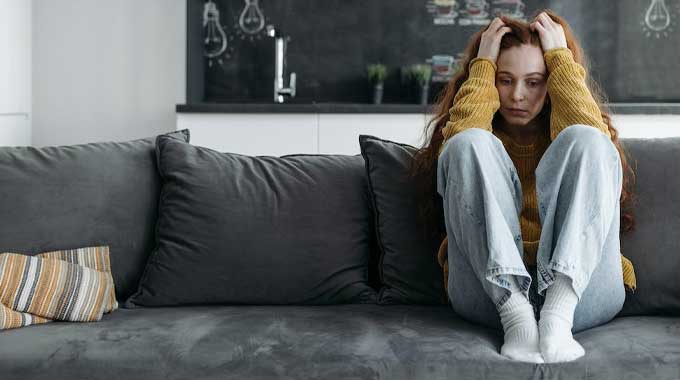Winter is often seen as a time of darkness, quiet, and slowing down. This is part of a natural seasonal rhythm which can be a perfectly healthy cycle. However, if the winter months are particularly difficult for you, and the change in season significantly impacts your mood, it could mean you are living with seasonal depression, also known as seasonal affective disorder (SAD).
- What Is Seasonal Affective Disorder Sad
- Symptoms Of Seasonal Affective Disorder Sad
- Major Depression Symptoms
- Winter Specific Symptoms
- Summer Specific Symptoms
- What Causes Seasonal Depression
- Biological Clock Changes
- Low Serotonin Levels
- Low Vitamin D Levels
- Increased Melatonin
- Less Socialization
- How Is Sad Diagnosed
- Treatment For Seasonal Depression
- Light Therapy
- When Should I Use Light Therapy
- How Long Does Bright Light Therapy Take To Work
- How Long Should I Use A Light Box
- Transcranial Magnetic Stimulation Tms
- Prevention For Seasonal Affective Disorder Sad
- Seek Help From A Mental Health Professional
Seasonal depression is usually associated with the winter months, however, there is also a less common form of the condition, called summer pattern SAD. Typical seasonal affective disorder (SAD) begins in the fall and will dissipate in the spring or early summer, while summer depression symptoms begin in late spring or early summer and last until the fall.
What Is Seasonal Affective Disorder (SAD)?
Seasonal affective disorder is a form of depression that is triggered by the changing of the seasons. Different from the winter blues, this condition generally leads people to have low mood, fatigue, and a loss of interest in activities they previously enjoyed. Some people may find their sleep cycles, appetite, and weight are impacted.
It is thought that SAD affects over 10 million people in the United States every year. Although it is common for everybody to experience the winter blues, the severity of winter SAD and summer pattern SAD can be so significant that it inhibits a person’s ability to function.
As a form of depression, SAD symptoms can impact how a person behaves, feels, and thinks. If you notice that your mood significantly changes as the seasons do, it could indicate you are living with this condition.
The typical manifestation of winter SAD begins in the late fall or early winter when the days are getting shorter and there is less sunlight. Mood will generally improve in the spring when the days stretch out and get lighter. We refer to this as winter depression. A less common, but equally as challenging form of seasonal depression is summer pattern SAD. This generally lasts through the spring and summer months and eases in the fall.
Additionally, individuals who have bipolar disorder may experience seasonal patterns in their symptoms at about the same times every year. This means that periods of mania may be associated with specific seasons. For example, summer may bring on more intense symptoms of mania.

Symptoms of Seasonal Affective Disorder (SAD)
As with all forms of depression, seasonal affective disorder is unique to the individual and can vary significantly. Typically, symptoms will last between three to five months of the year. They share features of major depressive disorder, as well as some symptoms specific to the season they are felt in.
Major Depression Symptoms
- Very low mood most of the day, mostly every day
- Loss of interest in things once enjoyed
- Altered sleep patterns
- Appetite gain or loss
- Weight gain or loss
- Lethargy
- Feelings of hopelessness
- Attention difficulties
- Suicidal thoughts or ideation
Winter-Specific Symptoms:
- Sleeping a lot
- Eating more than usual, particularly starchy and sweet foods
- Weight gain
- Isolating from others
Summer-Specific Symptoms:
- Sleeping very little
- Eating less than usual
- Weight loss
- Feeling restless
- Increased anxiety
- Violence or aggression

What Causes Seasonal Depression?
As with other forms of depression, it is not clear exactly why seasonal affective disorder develops. However, there are some factors thought to contribute to the condition.
Biological Clock Changes
Changes in the amount of available sunlight cause your biological clock to change. This impacts your sleep, hormone levels, and emotions. The change can be an abrupt adjustment and the body struggles to adjust.
Low Serotonin Levels
Our brain produces natural chemicals called neurotransmitters which communicate between nerves. One brain chemical is called serotonin. It is responsible for our feelings of positivity and joy. Somebody with low serotonin activity is predisposed to having depressive episodes. Sunlight plays a role in serotonin activity, so the darker days can further decrease the levels in somebody’s body, increasing the chances of depression.
Low Vitamin D Levels
Vitamin D, which is produced naturally in our bodies from high levels of sunlight, boosts serotonin. The lack of sun in winter can cause low levels of vitamin D, and in turn has an impact on our mood.
Increased Melatonin
Melatonin is a natural chemical that impacts sleep, emotion regulation, and more. Less sunlight is associated with an increase in melatonin. This can result in feeling fatigued during the winter months.
Less Socialization
During the winter, it’s common for people to stay indoors, and there are fewer opportunities to be outside with other people. This can lead to loneliness and isolation, two big factors contributing to depressive symptoms.
Seasonal pattern depression commonly begins in early adulthood and is more common in women than men. There is a scale of symptoms. Some people may experience a milder form which predominantly impacts energy levels, and others will experience seasonal major depressive episodes which significantly affect their everyday life.
People who live further from the equator are more likely to experience SAD.

How Is SAD Diagnosed?
Seasonal affective disorder is a form of major depression, so it is diagnosed in a similar way. SAD may be diagnosed if you experience mood changes that alter when the season changes.
If you have experienced the following over the past two years you may be diagnosed with SAD.
- Symptoms of depression or bipolar disorder that are associated with a specific season
- Some seasons where you usually don’t feel depressive symptoms
Trying to diagnose yourself is not advised. If you suspect you may be living with SAD, seek mental health advice. There are a number of conditions that share similar features such as chronic fatigue syndrome, immune disorders, underactive thyroid, and other mood disorders such as anxiety disorders.
A medical professional will use the Diagnostic and Statistical Manual of Mental Disorders and give you a physical and mental health evaluation. They will be able to help you understand your condition, and run tests to ascertain if there is something else going on.
After receiving a seasonal affective disorder diagnosis, your healthcare provider may refer you to specialists or talk through treatment options with you.
Treatment for Seasonal Depression
There are a number of treatment options for this mood disorder, many people benefit from a combination of therapies.
- Bright Light therapy: Light therapy uses a specific lamp to treat symptoms of SAD.
- Cognitive behavioral therapy (CBT): CBT is a form of talk therapy. Research finds it to effectively treat depression symptoms, and it tends to have the longest-lasting impact of any treatment approach.
- Antidepressants: Some people may benefit from taking antidepressant medications such as selective serotonin reuptake inhibitors to treat SAD.
- Increasing time spent outside: Increasing time spent in sunlight can have a big impact on symptoms. This includes choosing rooms and spaces which have lots of natural light.
- Vitamin D: Taking vitamin D supplements can improve your symptoms.
- Transcranial Magnetic Stimulation (TMS): This is a non-invasive brain stimulation treatment for depression.
Light Therapy
Light therapy uses a special lamp or light box which has white fluorescent lights covered by a screen to block ultraviolet rays. The light is approximately 20 times brighter than normal indoor lights. Light therapy works by exposing you to this light, but you should not look directly at it. The lamp can be placed around three feet away while you go on with normal activities. Some people may choose to combine antidepressant medication with light therapy to treat depressive episodes.
When Should I Use Light Therapy?
When you use light therapy can impact how effective it is. It is most beneficial to use it in the morning hours. There is a risk of causing insomnia or trouble sleeping if you use it in the afternoon or evening.
How Long Does Bright Light Therapy Take to Work?
Light therapy can have quick results. Some people will see changes within the first three to four days of use. The full effects may be felt around two weeks after use.
How Long Should I Use a Light Box?
It is recommended to use light therapy throughout the winter, at least until early spring. If you begin to use it and then cease to use it, winter pattern SAD symptoms may return quickly.
Transcranial Magnetic Stimulation (TMS)
TMS is a non-invasive, safe method of treatment for depression through brain stimulation therapy. Using electromagnetic pulses to stimulate nerve cells, magnetic fields are produced by an electrical current that flows through a coil. The current stimulates brain cells that are underactive, which is thought to be a common cause of depression. This stimulation results in a higher release of chemical messengers or neurotransmitters.
TMS can be an effective treatment for clinical depression and is especially beneficial if used in combination with talk therapy.
Prevention for Seasonal Affective Disorder (SAD)
Seasonal depression can affect anyone, which means preventing it is not always possible. However, there are some things you can do to prevent depressive episodes if you believe you are at risk, or if you have had one episode already.
Many of these measures are similar to treatment for seasonal affective disorder.
- Spending a significant amount of time outside, despite the weather. Even when there is not much sunlight, daylight can improve symptoms.
- Reaching out to a therapist can be extremely beneficial, even if you haven’t received a diagnosis. Talking through any stressful life events can reduce the chances of symptoms escalating into severe mental health conditions.
- Maintain a nutritious and healthy diet throughout the winter months. Often we crave carbohydrates and sugar through the colder seasons, but keeping up the fruit and vegetable intake and ensuring you get enough vitamins is crucial to sustaining good health.
- Move your body. Getting physical exercise every day can help you manage stress and boost feel-good endorphins. Be creative, this can be a hike with friends, a dance class, or a swimming session.
- Socialize with friends and family. It’s common to feel like staying indoors when the weather is cold, but maintaining friendships and spending quality time with people is good for well-being. Try to establish meet-ups throughout the week, and make time for phone calls with loved ones far away.
Seek Help from a Mental Health Professional
If the above symptoms resonate with you and you believe you are experiencing summer or winter pattern SAD, reach out to us today at GIA Chicago.
We understand how challenging living with seasonal affective disorder is, but we are here to help. Our diverse team of specialists has years of experience. We can get your SAD treated, helping you with a treatment program designed to work for your specific symptoms.
We use a combination of cutting-edge technologies and traditional talk therapies to ensure your recovery needs are always met. GIA Chicago can help treat your depression and get you on the path to wellness. Contact us to find out more about your treatment options today.





